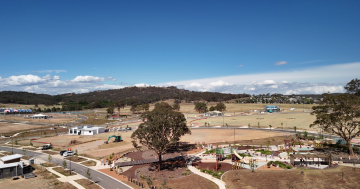
These now-and-after photos produced in the heritage report show the impact of the Jacka development on Elm Grove’s views. Photos: Eric Martin.
The impact of the proposed Jacka suburban development on the setting of the heritage-listed Elm Grove in Gungahlin will be catastrophic, according to a consultant’s report prepared for the rural property’s owner.
Rural leaseholder Paul Carmody has lodged his detailed objection to the Suburban Land Agency’s development application for Jacka 2, attaching three consultants reports on the heritage, Aboriginal heritage and ecological values of Elm Grove and adjacent land.
All three challenge or contradict the DA assumptions about the site in support of Mr Carmody’s objection
Eric Martin’s heritage report contains now-and-after photographs depicting the changed landscape around Elm Grove, showing two to three storey buildings on rising land and their impact on the existing viewsheds, which need to be included in any heritage assessment.
It also identifies the natural heritage values of woodlands in leased land currently being used by Mr Carmody as part of his farming operation.
The report says the current development application fails to adequately address known and detailed heritage issues that will be dramatically affected by the proposed estate development plan for Jacka Stage 1 and also future stages 2 and 3.
The DA also fails to address the requirements of the ACT Heritage Act, it says.

This artist’s impression shows medium density housing adjacent to the south-west corner of the Elm Grove heritage precinct.
Mr Martin concludes that the DA should be withdrawn and a new Jacka masterplan be developed that accurately defines and protects the setting of Elm Grove; protects the natural and woodland features of the area; and retains a larger rural buffer area on the south boundary of Elm Grove (Jacka 2 Stage 3) before planned playing fields commence.
The masterplan would need wide exposure so heritage issues are dealt with before a new Estate Development Plan is prepared.
Mr Martin says that although the DA is for Stage 1 only, the impact of the whole of Jacka 2 needs to be considered as it is an integrated estate development plan.
Past Traces found that despite the two reports cited in the DA, insufficient work had been done to clarify Aboriginal heritage issues and that local Aboriginal groups had not been consulted.
The DA states that the proposal complies with the mitigation measures recommended in a heritage statement endorsed by the Heritage Council, but the report says no Statement of Heritage Effects has been completed for Jacka 2.
”Such a document is necessary for the ACT Heritage Council to be able to assess and approve destruction of indigenous sites. Although sites have been documented and investigated, no approval for their destruction is provided within the DA application and it is unclear if this destruction has been authorised by the ACT Heritage Council,” the report says.
It also urges further consultation to document any intangible (landscape, cultural and spiritual) heritage values of the broader area surrounding Elm Grove, as the potential for harm is present.
”Until this additional work is completed, the full extent of impacts on the indigenous cultural heritage values cannot be stated,” its says.

The masterplan shows the extent of Jacka 2 and its proximity to the Elm Grove heritage precinct.
Capital Ecology’s report supports Mr Carmody’s claims that the DA understates the environmental values of land that he is now farming but is slated for development.
Its findings on the box gum woodland and endangered Golden Sun Moth habitat clash with the Gungahlin Strategic Assessment and ACTmapi cited in the DA.
The report says that except for the southernmost patch of vegetation, the distribution of box-gum woodland reported is largely opposite to that presented in the Gungahlin Strategic Assessment and ACTmapi.
It found 31 ha that met the Commonwealth listing criteria, nearly twice that identified in the Gungahlin Strategic Assessment and ACTmapi, and 35.8 ha that met the Territory criteria, about the same area but with a very different distribution.
Capital Ecology says the Gungahlin Strategic Assessment vastly understates the extent of potential Golden Sun Moth habitat.
”The potential habitat present in the study area is approximately 12.5 times more than that identified in the Gungahlin Strategic Assessment and 1.8 times greater than that identified on ACTmapi,” it says.
The study found a large number of mature remnant trees, 12 of which are identified on the ACT Tree Register and habitat for a variety of threatened woodland birds, concluding that the area is an important wildlife movement corridor across the northern border of the ACT.
Elm Grove is the last working property in the Gungahlin area. Mr Carmody has been there since 1985 and was instrumental in it being heritage listed in 2008.
Original Article published by Ian Bushnell on The RiotACT.








